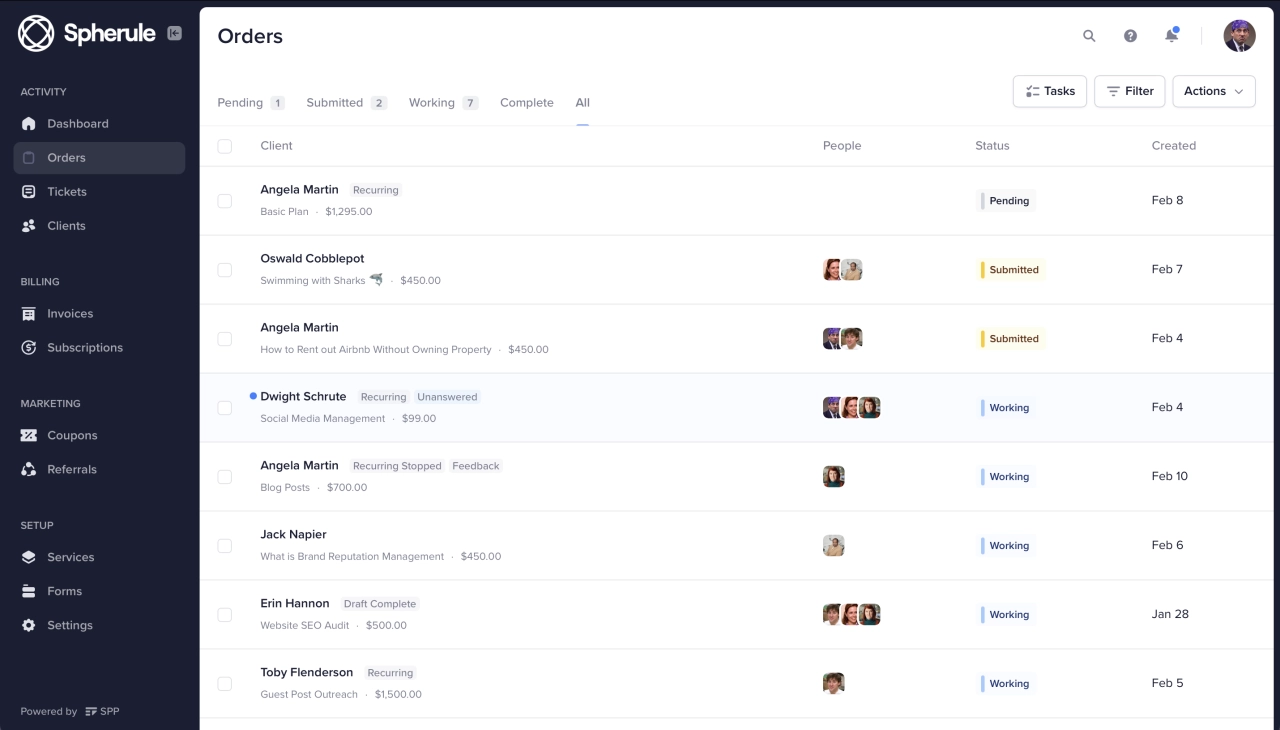- A new client onboarding process is a systematic approach that businesses use to welcome and integrate new clients into their workflow.
- An effective onboarding process can help businesses build strong relationships with clients, improve retention rates, and increase revenue.
- To create an effective new client onboarding process, businesses should identify key touchpoints, establish clear expectations and milestones, and regularly collect feedback from clients.
Acquiring new clients is hard—and losing them is easy. That’s an axiom of freelance and agency life—one you don’t have to resiliently accept. It’s one you can fight with plenty of tools and processes, though, such as efficient new client onboarding processes.
Do you want to learn more about building a agency client onboarding process that works for new clients? I’m tackling this topic, below—so read the guide to find out more.
What is the onboarding process of a new customer?
A client onboarding system (or process) is a set of steps you take to get acquainted with a new client. It starts the moment they get in touch with you and ends when their project is delivered. An onboarding process helps to ensure a smooth operational efficiency, maintain effective communication, and manage customer satisfaction.
Customer onboarding systems might seem boring, but a well-crafted onboarding process can be the difference between a long-term client and a one-time gig. Give it your time and attention and you’ll be rewarded with a happy and productive client relationship.
The 5 benefits of a client onboarding process
Building a customer onboarding process for your agency’s new clients brings many benefits. Let’s look at each of them below.
Set expectations: A thorough onboarding process will give you the opportunity to establish expectations early on. This way, both you and your client know what is expected on both ends, and any further questions can be addressed quickly.
Understand clients: To deliver quality services, you need to understand your client; who they are, what their pain points are, and what they need you to do for them. A client onboarding questionnaire enables you to gain a deep understanding of how you can best help your clients.
Increase retention: Naturally, a well-structured onboarding process helps to reinforce the client’s decision to work with you. It shows them that they have chosen a reliable and knowledgeable partner, increasing the likelihood of them returning for future projects.
Stay compliant: Verba volat, scripta manent, said Romans (words fly, but what is written remains). This old Roman saying stands true to date, and even more so when it comes to customer onboarding systems. A written set of processes gives you a paper trail that records the contact details and agreement terms between you and the client. It can help protect your business from any potential legal issues in the future.
Scale agency: The ability to onboard new customers quickly and efficiently can be a great asset if you decide to grow your business. A streamlined client onboarding process will make it easy for you to not just continue to onboard new clients, but also get them to recommend you to others so you can keep growing your agency.
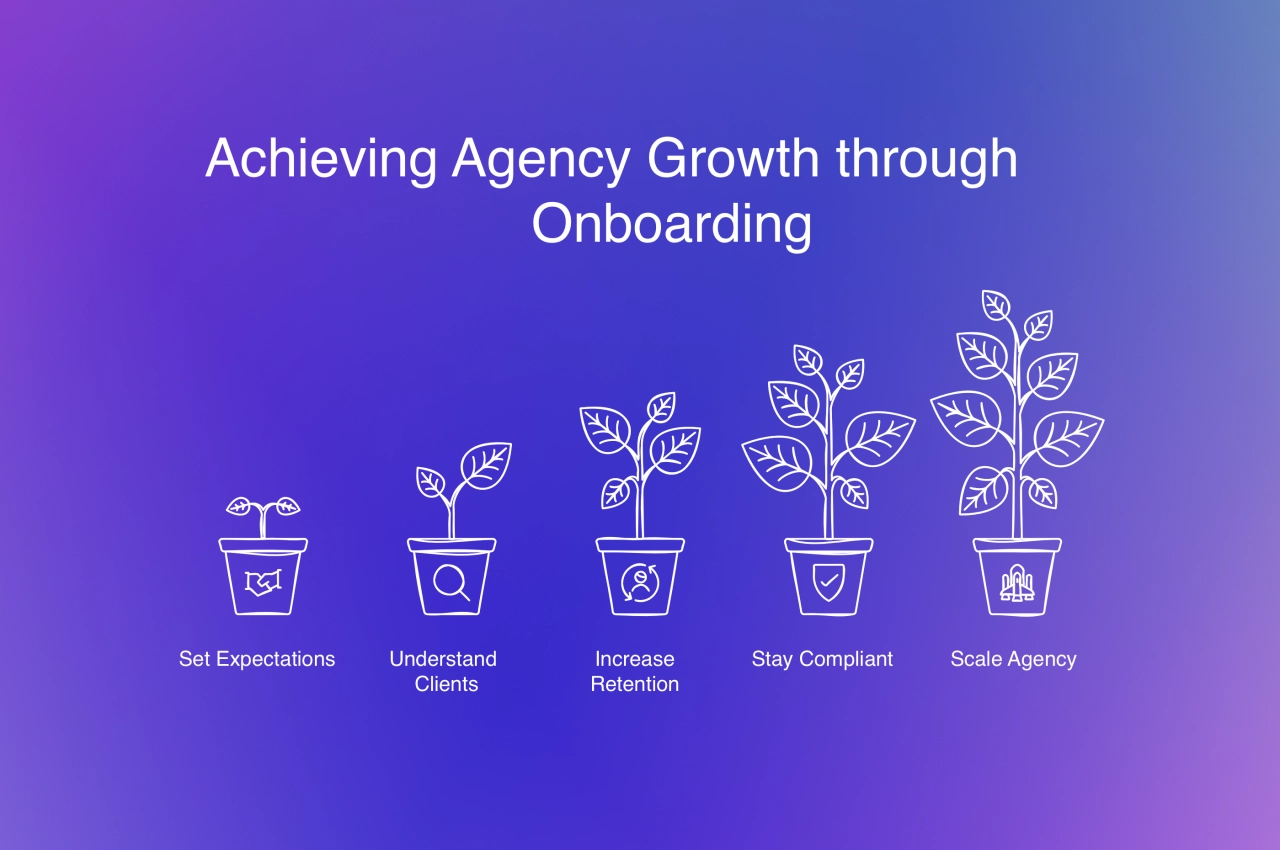
How do you successfully onboard new clients?
Alright, say you’re all set to start building your new client onboarding process. What should you include? Although the following step-by-step system isn’t a universal checklist and can be adapted, here’s client onboarding checklist you can easily follow.
Identify pain points
Before you jump on a thousand calls and onboard a new client, take some time to identify your client’s pain points—and figure out the solutions you could provide. An easy way to do this is by sending a branding questionnaire that allows you to get to know them better.
In the end, everyone is human, and they are looking for a solution to their problem. Don’t just sell them on your services, they might already be aware of them. Instead, figure out what their actual problem is, and how your service can help.
Let’s assume you’re a video editing agency and your client is concerned that the editor will constantly change. You can assure them that the same one will be assigned to all their projects.
Have a meeting
The initial client onboarding meeting is essential for building trust, understanding client needs, and setting project expectations. It usually includes introductions, a review of goals, timelines, and deliverables, and addressing client concerns. This structured approach promotes alignment, ensuring smooth collaboration and a solid foundation for long-term success.
Inquire if the client prefers regular follow-up meetings, such as on a monthly basis. They might feel it’s unnecessary, but explain that these meetings help keep projects on track and ensure everyone is informed. If they still believe it’s unnecessary, make sure your customer success team checks in with them via email.

To keep track of all your meetings, you can use Hubspot Meetings or Calendly. The customer success team should be looped in via your project management software. In SPP, you can create a task inside your project, assign a deadline, and a team member for the follow-up call.
Define your goals
No solid plan is ever made without clear goals. Spend time setting SMART goals (S – Specific, M – Measurable, A – Achievable, R – Realistic, T – Time-bound) for your client. This will help you align with their objectives, and break them into achievable targets.
Agree on deliverables
Once the goals are set, it’s time to agree on deliverables. That’s when you’ll decide who does what and when.
This part is key to make sure that everyone involved in the project is aware of their responsibilities and can complete tasks in a timely manner.
The easiest and most automated way you can get all the data you need is by asking the right questions. For instance, SEO agencies can use an SEO intake form to inquire about project-specific details.
Gather every detail
This is where you should double-down your effort to get into all the nitty-gritty details of the project. Show your client that you have not just done your homework for an A+, but you’re aiming for the extra points too. Ask questions, get everything in writing, and make sure you’re both fully aligned.
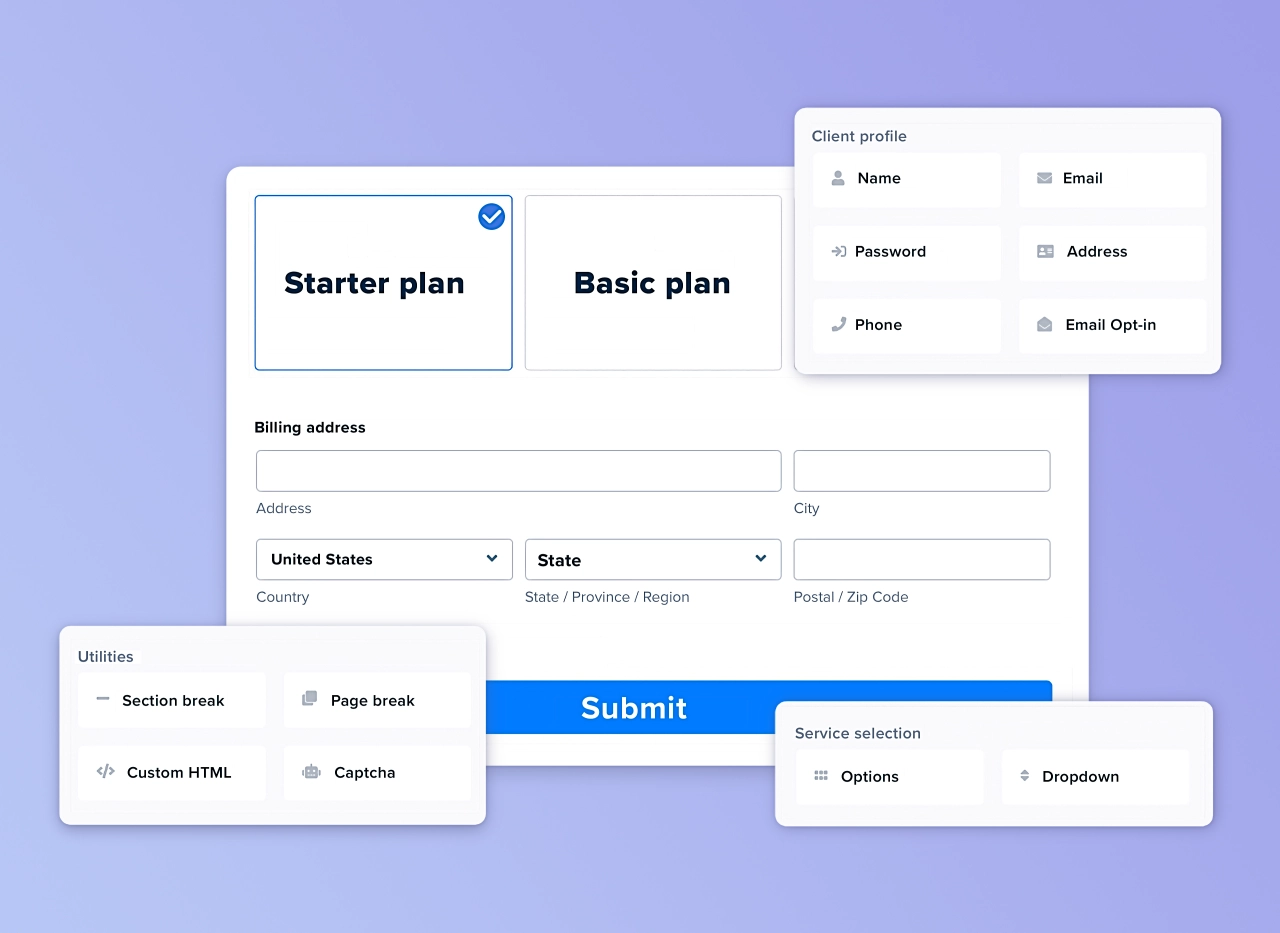
Collect project information, client data, files, and more.
If you’re using SPP, you can also educate them about your intake forms that your clients can use to fill out. There won’t be a need for constant calls, instead, they can give you all the information you need in writing.
Sign a contract
Effective contract management is crucial in business. It’s not a deal until everyone signs on the dotted line. Contract signing makes it all official and details the agreement between you and your client.
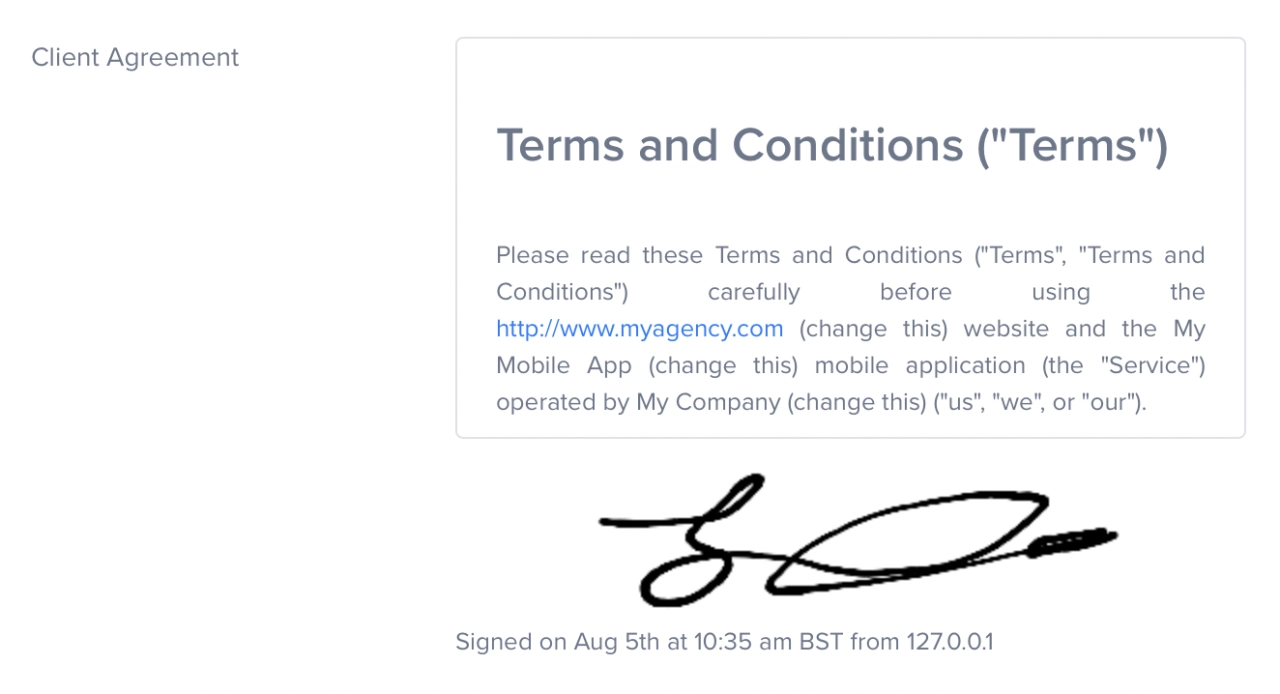
While productized agencies rarely rely on signed contracts, you can still get a signature from your clients by adding SPP’s signature field to your order forms.
Learn about your client’s internal processes
At this point, you have already discussed the project details and know what you have to do. Your client is likely quite comfortable with you, so now is the time to learn about your client’s internal processes, such as their communication processes, their ways of working, and their internal policies. If you can get a better understanding of how the client works internally, it will make your collaboration a lot easier—and it will help you align your agencies ways of doing things to those of your client.
Mind you, this is not to say you should change your internal processes to accommodate every new client that comes your way. But sometimes, by adjusting a few small things in how you work with a specific client, you can make your client’s day-to-day operations much smoother and help them achieve operational excellence. Consequently, you can make it more likely for them to eventually recommend you to someone else.
Define success
To ensure a successful collaboration, you should constantly (re)emphasize what success looks like, for example through reports.

Before you proceed to the actual work, remember to re-iterate the deliverables and make sure that everyone knows what is expected from them, and when it should be delivered. This will help you and your client stay on the same page regarding what should be delivered and when, and it will make it easier for you to measure success.
Agree on milestones
As a final step of your new customer onboarding system, make sure to agree on the milestones for the upcoming months and make a plan for your next 30-60-90 days. This will give you and your client an overview of what will happen in the near future and it will help you keep track of your progress.
Define communication cadence
If you don’t want to wake up to desperate calls from your clients, but you still want to make sure they’re always in the loop, you should agree on a communication cadence. Depending on the type of services you offer, you can decide to communicate daily, weekly, or a couple of times per month.
Another option is to generate reports in Whatagraph that your clients can easily check up on whenever they want to. This lessens the burden your team has to reply to questions, and makes it also easier for customers to stay in the loop.
Send a welcome packet
Once all the legal technicalities are out of your hair, send your client a welcome packet. It can be a welcome email with all the resources, file management systems, and tools they need to have access to.
While welcome emails do have a nice touch, they often lack all the fine details to onboard new customers efficiently, which is why you should make use of a proper onboarding page; more on that later, though.
Use a new client onboarding process template
At this point, you’ll probably want to put your newly acquired knowledge into practice, but where do you even start? Luckily, we have a client onboarding process template for you in Service Provider Pro.
Head to Settings → Onboarding to open our onboarding page builder, including the default template that we’ve prepared for you.
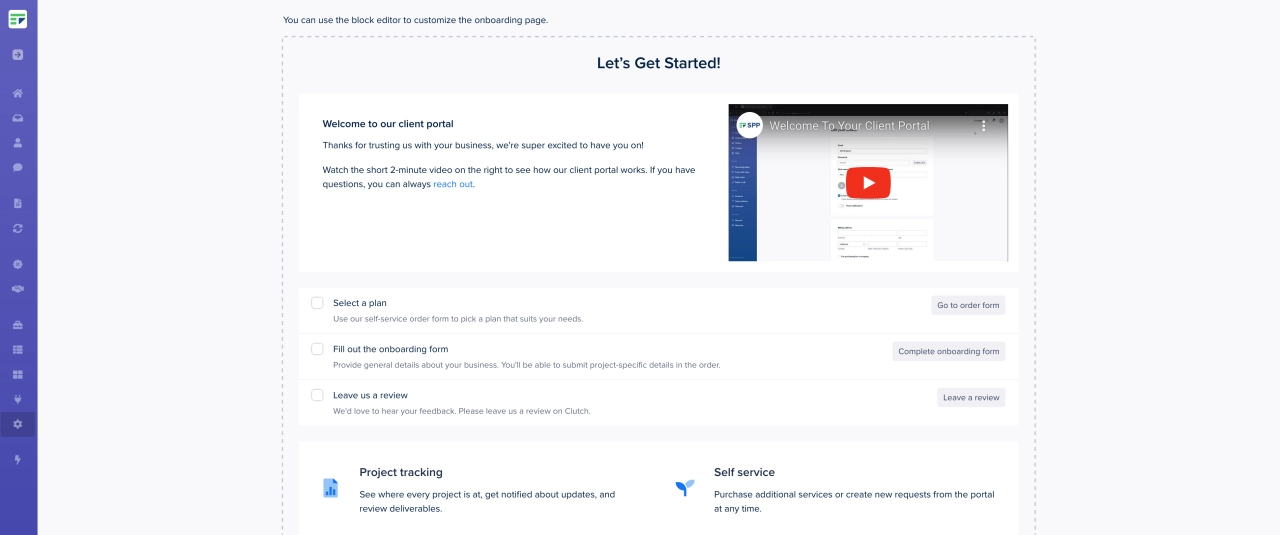
You can change every element of the client onboarding process page, even the video. Plus, you can set up an checklist for onboarding new clients.
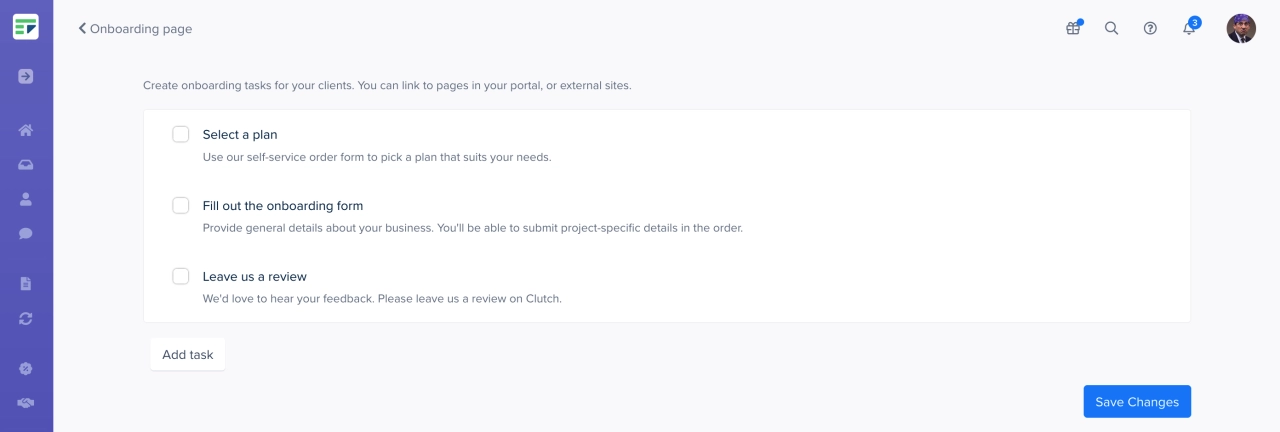
The handy checklist makes it easier for them to follow clear instructions without your team having to explain everything multiple times.
You can also add a new client onboarding form to the page to gather information about the person or company, for instance:
historic company information
brand assets
preferred communication settings
The client onboarding form is always accessible so your customers can view it, and change the data at a later time. This ensure that your team has always up-to-date information at hand.
Building the perfect new customer onboarding process
Finally, let’s take a quick look at some of the best practices you should keep in mind for a successful new client onboarding process.
Focus on the human side: Onboarding new clients can be nerve-wrecking and intimidating, so make sure you don’t forget that, in the end, you’re all humans. People smile, they have real pain points outside of work, and they need to be reassured. Pay attention and make sure you act with empathy at all times.
Be proactive: Don’t wait for your clients to come to you—be proactive in finding solutions, communicating with them, and always do your best to ensure their satisfaction.
Showcase value early in the process: Want to make sure your clients love you from the get-go? Showcase the value you can bring early in the process and prove that their trust was well-placed.
Be transparent: Transparency is key for successful client onboarding and long-term relationships. There’s no point in hiding things (or worse, lying about them.) At the end of the day, it will only hurt your reputation.
Automate where necessary: You cannot automate human relationships. Automate client onboarding where human interaction is not required.
Use the right tools: Your onboarding shouldn’t just be a bunch of automations. Use dedicated client onboarding software that was built for this type of tasks, and automate ontop of it if necessary. It should also have a client feedback feature that allows you to gather information on how to improve your processes

When it comes to automation, you can send messages when you’re out of office, send data to external tools, or import data from them into your client onboarding portal.
Good agency client management software should have all the features you need to help you in this case.
Improve your new customer onboarding process
They say first impressions matter—and I couldn’t agree more. With a well-crafted onboarding system, you can make sure your clients are in the best hands from day one. From setting clear expectations and communication schedules to delivering excellent results, onboarding workflows can set you (and your clients) up for success from day one.





